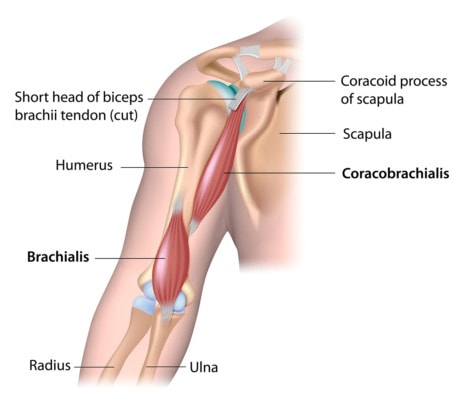Biceps Tenodesis Side Effects: They Did What to You?
I have a running list that I keep of the dumbest surgeries. One of my criteria to make the list is when I first hear about the procedure from a patient I am shocked enough to say out loud, “They did what to you?” While I’ve known about the concept of tenodesis for many years, when I received a recent e-mail from a patient telling me about his screwed-up shoulder as a result of this procedure, I found myself saying those same words in my head! Hence, it’s time for a blog on why biceps tenodesis has been added to my dumb-surgeries list.
What Is Biceps Tenodesis?
The long biceps tendon (see below) comes up the humerus bone and sits in a groove. It attaches to the top of the joint where the labrum lives. In a biceps tenodesis, the surgeon disconnects the long head of the biceps tendon from its attachment at the top of the shoulder joint socket. The tendon is then reattached elsewhere, often anchored lower down in its groove.

Alila Medical Media/Shutterstock
Sometimes this is done in older patients because the tendon is inflamed, often during a rotator cuff repair surgery. Another reason this procedure is performed is in a younger patient with a SLAP tear of the labrum. The labrum is the lip of the socket where the ball of the shoulder joint fits. The top of this area is called the superior labrum, and a tear here is often given the acronym SLAP. The concept behind both of these procedures is that they take pressure off the biceps tendon itself, or in the latter instance, this takes pressure off the healing superior labral tear.
What Are Biceps Tenodesis Side Effects?
This is a surgery, so side effects include infection, failure of the new biceps tendon anchor, chronic pain, and so on. In one recent publication, common biceps tenodesis side effects were listed as cosmetic deformity of the arm (pop-eye biceps), cramping or soreness in the biceps muscle, and loss of biceps strength to bend the elbow or supinate the forearm.
Does This Need to Be Done?
The only way to tell if biceps tenodesis is effective is to perform studies where people are randomized into groups where the tendon is cut or not (sham surgery) and then measure outcomes. Regrettably, like the rest of orthopedic surgery, there are few such studies. In fact, I could only find one. The results of that study show me that it’s unlikely that this procedure would be more broadly effective when compared with a fake surgery.
This new study looked at patients who had a type-2 SLAP tear. In this very common type of tear, the rim of the biceps attachment at the larum is torn, see table below for more details:
This study had three groups. One that was assigned to sham surgery (nothing was done), one that had a SLAP repair (sewing or anchoring the tear back together), and a third group that had a biceps tenodesis to take pressure off of the superior labral tear so it could heal. The outcome? There was no difference between either the SLAP repair or the tenodesis from the sham or fake surgery. Meaning both the SLAP repair and the tenodesis procedure were no better than no surgery.
With Interventional Orthopedics It’s Time to Relegate Most Tenodesis Surgeries to the Dustbin of Medical History
Today, in my experience, we can precisely inject agents that will cause healing of these tears or the irritated and damaged tendon without the need to rip the tendon from its attachment. Hence, most biceps tenodesis surgeries should soon go away. These newer procedures often use platelet-rich plasma or bone marrow concentrate injected into the tears. In addition, they have much faster recovery times and are much less invasive, so this means far fewer side effects.
A word of caution, performing this type of injection under imaging guidance is an advanced interventional orthopedic skill. That means that an orthopedic surgeon or the average physician who injects PRP or stem cells is very unlikely to have the expertise to perform this procedure. In addition, it helps to have both ultrasound guidance and fluoroscopy available to perform the procedure correctly. If you have any questions about which providers are trained to perform this procedure, we keep a list of our Regenexx providers who have mastered this delicate injection, and the IOF (a nonprofit—Interventional Orthopedics Foundation) also maintains a list of providers who have passed their advanced shoulder coursework. To learn more about advanced shoulder injection procedures, see my video below:
The upshot? Why would you sign up to have your biceps tendon chopped off and then screwed back into bone and risk biceps tenodesis side effects when the research doesn’t show that this procedure is any better than a fake surgery? In the meantime, precise injections into the irritated tendon or into the SLAP tear can usually reduce pain and get you back to functioning again!

If you have questions or comments about this blog post, please email us at [email protected]
NOTE: This blog post provides general information to help the reader better understand regenerative medicine, musculoskeletal health, and related subjects. All content provided in this blog, website, or any linked materials, including text, graphics, images, patient profiles, outcomes, and information, are not intended and should not be considered or used as a substitute for medical advice, diagnosis, or treatment. Please always consult with a professional and certified healthcare provider to discuss if a treatment is right for you.
